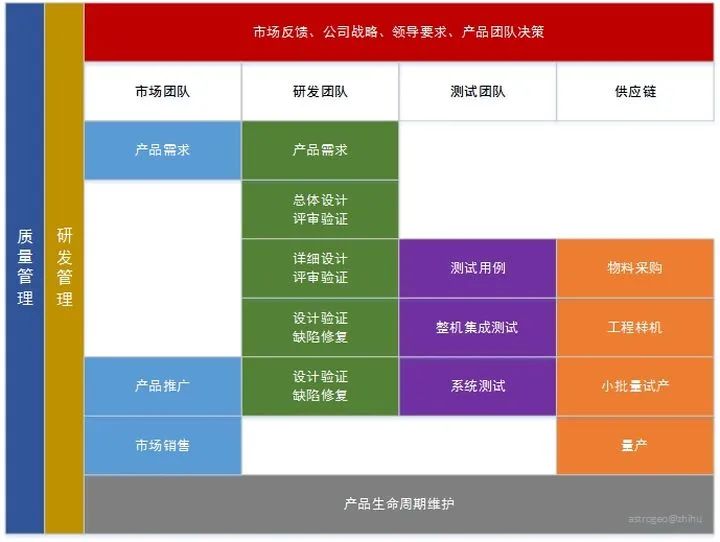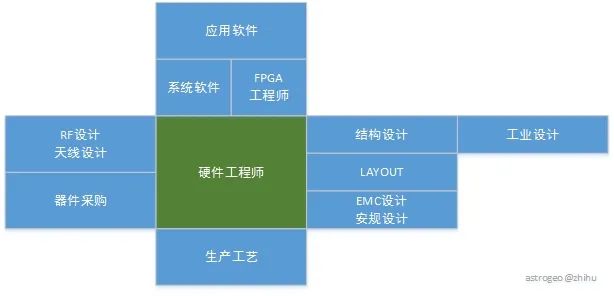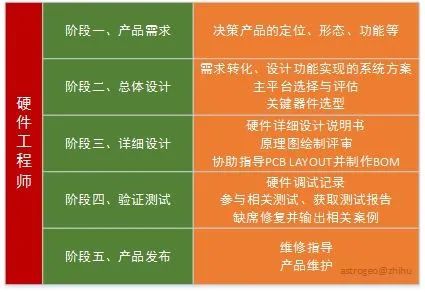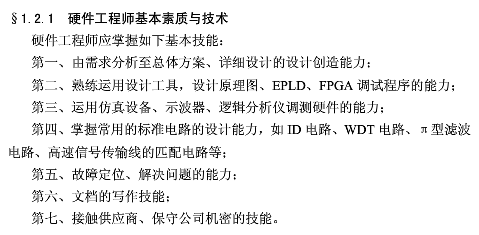Skip to content
In a narrow sense, software and hardware generally refer to the electronic field.
Software code is also written by people, and the languages we are familiar with, such as C, C++, etc., are translated into assembly language by compilers, and then assembly language is translated into binary machine language by assemblers, which controls gate circuits to complete corresponding actions. For the differences between C and C++, you can refer to this article: If C and C++ are two kitchen knives.
Personally, I believe that without hardware, software has no meaning to exist; hardware is the foundation of everything, which shows how important hardware design is.
However, there is a clear distinction between software and hardware, at least their work content is very different. According to industry descriptions, hardware belongs to the bottom layer (usually referred to as low-level hardware), while software is called the upper layer (software is further divided into: low-level drivers, upper-level business, and application layers, etc.). If one must give an example to illustrate software and hardware, the best analogy is a person, where hardware refers to the human body, while software refers to human thinking.
In fact, for people outside the electronic field, it is hard to understand how computers work, how hardware works, and how software works. Related articles: In-depth article: How STM32 Microcontroller Combines Software and Hardware. Even if you know it’s all 0s and 1s, if you haven’t done related work, you won’t discover the magic behind it. Actually, you just need to know that software drives hardware to work, and what drives it is electrical signals! The electrical signals received by hardware are divided into 0 and 1, and the response speed of hardware is very fast. How fast? For example, a commonly used serial port baud rate in hardware is 115200 bits per second, which means 115200 0s or 1s in one second. An English letter is 8 bits (as can be seen in the ASCII table, which is taught in university), so that means 14400 letters can be printed in one second. You can blink, and over ten thousand letters will come out. Of course, it’s not actually that many; this is just a figurative example.
Generally speaking, hardware design refers to circuit design, and this statement is not incorrect because all your work revolves around circuit design, and the ultimate goal is to produce an excellent circuit that meets various requirements and withstands various tests. However, what we actually require is a product, not just a circuit board.
There is an article online that explains this well: “Hardware design is based on the product manager’s requirements (PRS – Product Requirement Specification), under the requirements of COGS (Cost of Goods Sold), utilizing currently mature chip solutions or technologies, completing hardware products within the specified time, while meeting the following requirements:
-
-
-
-
-
-
-
-
-
-
-
-
-
Design for Manufacture (DFM)
One can see that a successful hardware design, the realization of major functions is only a small part of all processes. When I first started working, I thought that once the circuit design of the board was completed, I had finished 50% of the work, and once the PCB returned with the main functions realized, I had completed 80% of the work. In fact, that is not the case; once the PCB returned with the main functions realized, I hadn’t even completed 30% of the work. Therefore, whether in terms of time or stages, hardware design for the product is a long process.
Moreover, when you work on product hardware design in a company, you generally refer to mature solutions. The main functions of the main chip CPU still ultimately rely on the chip manufacturer’s provided solution. Generally, to reduce risks, the design is mainly completed by referring to the reference design provided by the chip manufacturer, which also provides all materials including device packaging, reference design, simulation models, PCB reference, etc. In today’s world, where chip functions are becoming increasingly complex, a single chip often has hundreds or thousands of pins, and for a new project, there is no time to thoroughly understand each pin, each input/output’s specific function, and electrical parameters, especially for high-speed designs like DDR3 interfaces, XAUI interfaces, etc. Generally, the reference design provided by the chip manufacturer is the best solution they have developed, verified, and tested. In many cases, you must follow the reference design; otherwise, there may be problems with the hardware, usually signal integrity or EMC issues.
Some people may say that hardware circuit design does not count as design; it’s all about copying mature circuits. Chip manufacturers provide increasingly comprehensive services, and combined with the technical accumulation of the company, hardware design engineers can completely design circuits without thinking. It seems that the value of hardware engineers (HWE – Hardware Engineer) is decreasing, as the core functions or technologies of a product are generally in the IC or FPGA, and HWE usually lacks the ability to design core logic (IC design). If this logic is followed, software design can also be said to be designless, as it’s all about copying mature code. How many software developers do not port others’ code? To delve deeper, how many software engineers can freely modify uboot, kernel, without searching for C language syntax, without porting business programs, or without consulting the chip manufacturer’s technical support? Even if they are all mature components, in practice, I have not found any project that is done quickly. The same set of circuits and code, mature products have no issues, why do new products have issues? Ultimately, it is still the hardware design that solves it.
Regarding the above questions, I have also been confused. I always felt that hardware design was no big deal; it was just copying reference designs, just like assembling a computer to assemble a single board. However, as my project experience has increased, especially with my current role in hardware system-level design, I feel that I was originally considering problems more from the perspective of a schematic design engineer, which was very one-sided. As mentioned earlier, a successful hardware design, the function is only a small part; regarding other factors and capabilities, the ability of an HWE depends on how many factors they can consider and how deeply they can go, the more they can, the better an HWE engineer they become.
Therefore, HWE relies on experience; for companies, cultivating an HWE is very costly. Hardware does not allow for quick fixes like software; if a hardware design is wrong, it may need to be redone entirely, delaying the entire project cycle by 3 weeks or even more than a month. For example, recently encountering a SENSOR that outputs images poorly, with many bright spots, the hardware circuit cannot be bridged, and this relates to layout and wiring, requiring a board change.
One viewpoint needs clarification: you can do things without understanding anything, but there will be a developmental ceiling for the individual. In hardware, it’s like reference circuits; you can use them without knowing how they work. In software, it’s like uboot and the kernel; you can use them without understanding them, but once you understand, it’s different. When it comes to hardware design, everyone thinks it’s just circuit design, which seems simple and not difficult, but in reality, it is not; the deeper you go, the harder it becomes, the greater the responsibility, and the more departmental communication is required. The more you understand, the easier it is to learn, and the further you can go.
What is Hardware Circuit Design
Hardware circuit design is about designing circuits, being able to proficiently use EDA software like Cadence to draw circuits and view PCBs. Circuit design in hardware design is the most important responsibility of HWE. Circuit design tests the basic skills of HWE, namely the understanding and flexible application of some hardware components, such as:
-
-
Resistors, capacitors, inductors
-
-
Protection devices, interface devices
-
Logic chips, logic functions
-
-
The relevant matters discussed regarding hardware design should be considered during the design phase. Currently, various processes in large companies ensure good interdepartmental collaboration during design.
Every company will have its own hardware circuit design specifications, which need to be carefully reviewed and applied in practice. Hardware circuit design mainly targets circuit design, which involves a lot of things; there will be a separate chapter discussing the design of circuit modules later. Hardware circuit design requires sufficient experience and theoretical knowledge.
Hardware Design Development Process
After the hardware department development process is specified, personnel in the hardware department must strictly follow the development process to complete their work. The hardware department’s development process is mainly divided into the following steps.
For the upcoming project, market research needs to be conducted.
After completing market research, project initiation work needs to be carried out.
After project initiation, overall hardware design needs to be conducted.
-
Core Component Experimentation and Detailed Module Design
After completing the overall design, experiments on core components need to be conducted, and modular design schemes need to be started.
-
Circuit, Program, and Shell Design
After the experimentation of core components and detailed module design is completed, circuit, program, and shell design can begin. Circuit, program, and shell design should follow the project specifications.
-
System Integration Testing
After each module is debugged, system integration testing can be conducted.
-
Internal Review and Project Acceptance
After system integration testing is completed, the project can undergo internal review and acceptance.
What is a Hardware Engineer
Hardware engineers are responsible for the hardware design of the entire product.
The R&D process of a hardware product is shown in the following diagram:
All positions within the company are equally important. Although the importance of each team is consistent, the position of the R&D team in product development should be more core. R&D personnel can transition to roles in marketing, testing, supply chain, or quality management, but it is difficult for personnel in marketing and other positions to transition to R&D. Firstly, the threshold for R&D is high, and secondly, R&D work has a broad exposure. Among the entire R&D team, hardware engineers play a leading role.
Generally, when we talk about R&D, it is not limited to just software and hardware, but the entire project team, which includes product leaders from almost all departments.
Hardware engineers are an important member of the R&D team, and the R&D team for hardware products can be illustrated in the following diagram:
Of course, the above diagram does not fully represent the situation; for example, thermal design is also a very important member. However, it should be noted that in the entire project R&D team, there are two individuals who interact with everyone: one is the project manager, and the other is the hardware engineer. Hardware engineers need to communicate and coordinate with various R&D personnel, which requires them to have a broad knowledge base and strong coordination skills.
The primary responsibilities of a hardware engineer are illustrated in the following diagram:
Hardware engineers can generally be divided into the following four stages:
Completing parts of stages three and four under the guidance of others, which is typically achievable within three months for fresh graduates.
-
Ordinary Hardware Engineer
Independently completing stages three and four work, generally achievable within 1 to 2 years.
Leading the completion of stages three and four work, participating in the overall design work of stage two.
Leading the completion of stages one and two work.
As a hardware engineer, you are responsible for the entire product R&D process. Therefore, it is essential to have precise control over each time period. Projects will have project cycles; although the project manager controls the timing, the specific operations are still managed by the hardware engineer.
The goal of a hardware engineer is to achieve zero defects in the product.
In this process, it is necessary to design circuits, debug, and communicate with various departments, requiring improvement in all aspects of skills.
Regarding the basic qualities and techniques of hardware engineers, the following is the positioning from the Huawei hardware engineer manual:
Finally, let’s talk about the self-cultivation of hardware engineers.
-
Communication Skills: Must be logical and comprehensive in thoughts to communicate well with personnel from other departments; unclear communication can lead to arguments!
-
Gentle Personality: Since you will be interacting with all departments, don’t have a stern face or be commanding; an extreme personality can lead to arguments!
-
Humble and Cautious: Even if you do not adopt others’ opinions, you should listen and then express your views and reasons; being obstinate can lead to arguments!
-
Attention to Detail: Designing circuits requires meticulousness, and debugging also requires carefulness; once a problem occurs, the responsibility falls solely on you!
-
Patience: Whether in communication, debugging, or checking circuits, patience is essential!
-
Ask When Unsure: If you do not understand something, ask, as product development time is short, and you cannot expect a lot of time to research!
-
Responsibility: Be accountable for the circuit, the product, and bugs!
-
Prioritize: When problems arise, first think about how to solve the issue rather than who to blame!
-
Willing to Learn: Be helpful to others, eager to learn, and must have solid experiential knowledge and theoretical knowledge!
In summary, the above are essential character traits that a hardware engineer must possess; none can be lacking. Individuals with extreme personalities are not suitable for hardware R&D, and it can even be said that they are not suitable for all R&D. Therefore, generally, many hardware engineers transition to product manager roles, as this position itself has high requirements, and good character along with experiential and theoretical knowledge will enable continuous improvement.



